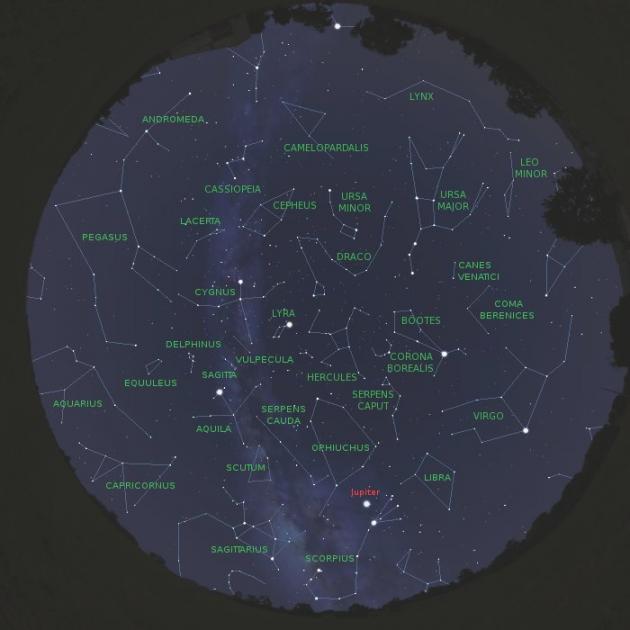- News / Thoughts
- Astronomy Guide
- On This Day
- Reviews
- Bookstore
Astronomical Events for July 2007
07/02/2007Planets Saturn and Venus are with us for over a year, but in the next ten days or so, they'll be lost from the evening sky. Except for Jupiter and it's satellites, we won't be having any interesting planets this month. Jupiter will be on the celestial sphere all night, but closeness to horizon will not bode well for detecting details on it's surface. But if you're up to it, you can try to find Uranus, Neptun or Pluto, which are also up in the evening hours.
This month Earth will be at aphelion (farthest point from the Sun), and it's night side will be turned towards center of our galaxy - Milky Way. Thus we can observe many summer objects, among which most are nebulae and globular clusters.
Also we expect NASAs satellite Dawn to launch, which will start its journey toward asteroid belt and explore dwarf planet Ceres, and asteroid Vesta.
O

Evening sky for the middle of July 2007. at 10:30 PM. The map is valid for northern hemisphere, especially positions near 45 degrees latitude.
From the beginning of this year we've been observing two planets. Venus was an evening star, which last month reached amazing distance from the Sun of 45°, and because of that stayed long into the night on celestial sphere. Saturn was also our guest of the evening sky, adorning it with it's rings. In orbit around him there is man made satellite Cassini, which already sent us many intriguing informations and pictures to the amazement of scientists and amateur astronomers. But in the beginning of this month both planets will disappear in the glow of the Sun. We'll lose Saturn until the next year, and Venus will, beginning with next month, become morning star. As if to say goodbye to us, Saturn and Venus will be very close to each other (conjunction of 0.8°) on July 1th, which many astro photographers will appreciate :)
The only remaining planet on which you can detect any detail is Jupiter, but this year it skims pretty low near horizon, so seeing won't be good. It is interesting to note that its south equatorial belt is quite faded which also happened during the 1987 opposition.
Planets Uranus and Neptun, and also dwarf planet Pluto are also observable in the evening, but unfortunately they are so far away, we can't see any detail on them. But it can be fun finding them anyway.
This month, on July 7th, Earth will be on the most distant point from the Sun, aphelion. In schools, when describing seasonal change, Earth is usually shown traveling on quite elongated ellipse, so many kids, logically, come to conclusion that we have coolest weather when we're furtherest from Sun. But it's not true because of two reasons. Earths path is almost circular, elliptical eccentricity is so negligible that we can consider it's always traveling at the same distance from Sun. Second reason is that northern hemisphere is warmest exactly at the time of aphelion, that is we're in summer season. Difference of seasons between north and south hemisphere gives us a clue that distance from Sun doesn't matter much in triggering seasonal changes, but Earth axis tilt does. When suns rays fall under steep angle, the surface of the Earth is warmer, then when the rays fall under shallow angle because then the warming effect is diminished, and surface is cooler. So it's the Earth tilt that's governing changing of seasons and not the distance from Sun.
Right on aphelion date, July 7th, a NASAs satellite DAWN will be launched. This satellite will start its journey toward asteroid belt, where it'll research dwarf planet Ceres, and asteroid Vesta. This science mission will explore their inner structure, density and other characteristics, because they are considered to have remained unchanged since the forming of our Solar System. With success of this mission we'll be able to further our understanding of the early stages of our planetary system, given that there were a lot of such bodies, called protoplanets, which collided and crashed, creating what we today know as planets.
It is interesting to note that both of this bodies are viewable from Earth, although when looking at them through amateur telescopes they appear as faint stars. Vesta is located in the Scorpius constellation, and will range in brightness from 6.0 magnitude at the beginning of the month towards 6.6 magnitude at the end of it. Ceres is in the Cetus constellation and has brightness of 9th magnitude. Ceres will brighten a bit during following months when we'll be able to observe it before midnight.
And to end this events review with moon phases for July 2007:
- Last Quarter - July 7. 16:54 UT
- New Moon - July 14. 12:04 UT
- First Quarter - July 22. 06:29 UT
- Full Moon - July 30. 00:48 UT